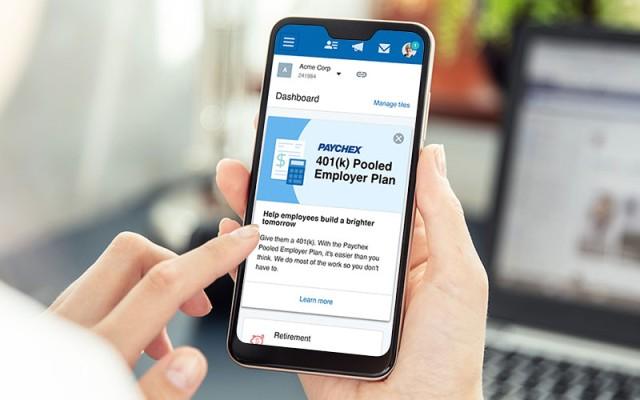
Pooled Employer Plans (PEP) Are an Easier Way To Offer 401(k)
Reduce your 401(k) plan costs, simplify compliance, and unlock valuable tax incentives while offering your employees a high-quality retirement benefit. With Paychex PEP, we take on the tough stuff so you can focus on running your business.
What You Gain With PEP
Reduced Liability
We handle most of the financial and legal responsibilities you'd normally be responsible for, which means less liability and risk for your business.
Cost Savings
Get access to better pricing that big companies often receive by joining with other employers, plus tax credits that could make your plan free for years.
No Audit Headaches
We handle all required audits automatically, potentially saving you $10,000 to $20,000 while eliminating the time and stress.
Decreased Workload
We take care of IRS filings, compliance, and employee education. All the 401(k) benefits, none of the work.
Your Path to a Pooled Employer Plan
- Join the PEP: Access premium retirement benefits without the hassle of managing your own 401(k).
- We Handle Administration: We act as the plan sponsor, taking on fiduciary responsibility and managing compliance and oversight.
- Enroll Employees: We provide easy enrollment tools plus educational support for your team.
- Ongoing Management: We handle IRS filings, audits, and updates, so you can focus on your business.

Think 401(k) Plans Are Too Expensive? Think Again
Small businesses can now take advantage of SECURE Act 2.0 tax credits to save big with new 401(k) plans. These credits may cover 100% of startup costs (up to $16,500 over 3 years) and provide up to $1,000 per employee annually for employer contributions.1

Which Retirement Plan Fits Your Business Best?
Not sure which retirement plan to offer? Compare the features of a Pooled Employer 401(k) Plan vs. a traditional 401(k) plan.
PEP or Traditional 401(k)
Pooled Employer 401(k) Plan
Traditional 401(k)
Potentially reduced administrative costs.
Gain access to plans normally reserved for bigger companies.
Potentially higher administration costs than a PEP.
The Pooled Plan Provider is the Plan Sponsor and relieves the employer of significant fiduciary liability.
The employer has more control but also more fiduciary risk.
The Pooled Plan Provider significantly reduces plan set-up responsibilities, including contracting with vendors and the investment manager.
As the plan’s sponsor, the employer is involved in plan setup, design, investment selection, and vendor coordination.
The Pooled Plan Provider assumes responsibility for audits, potentially saving employers $10,000-$20,000.
The employer of a large plan must oversee and pay for costly audits.
New plans may be eligible for up to $16,500 in tax credits per year for 3 years, and the possibility of an additional $1,000/employee per year with employer contributions.1
New plans may be eligible for up to $16,500 in tax credits per year for 3 years, and the possibility of an additional $1,000/employee per year with employer contributions.1
Tailored Packages To Meet Your Needs
Paychex pooled employer plans work for businesses of all sizes and integrate seamlessly with Paychex payroll. The PEP is available by itself or bundled with other valuable Paychex payroll and HR solutions for added support.

Unlock More Value With Additional Paychex Services
Experience the strength of Paychex through seamless, integrated solutions on one easy-to-use platform.
Recommended for You
Contact Us Today About Starting Your Pooled Employer 401(k) Plan
Pooled Employer Plan FAQs
-
Is the Pooled Employer Plan (PEP) a Good Retirement Plan for My Business?
Is the Pooled Employer Plan (PEP) a Good Retirement Plan for My Business?
A Pooled Employer Plan (PEP) is an excellent retirement plan option for small to mid-sized businesses, especially those without an existing plan. It offers professional administration, reduced employer liability, and simplified management. By pooling resources, businesses may also benefit from cost savings. For companies already offering a retirement plan, switching to a PEP can significantly reduce the time and effort required for plan administration. Additionally, a PEP fulfills the requirements of states with mandatory retirement savings laws.
-
I’ve Wanted To Start a Retirement Plan for My Business and Employees, but It Seems Too Complicated. How Will the PEP Be Different?
I’ve Wanted To Start a Retirement Plan for My Business and Employees, but It Seems Too Complicated. How Will the PEP Be Different?
Managing a 401(k) plan can be challenging for business owners due to the complexities of compliance and administration. A Pooled Employer Plan (PEP) simplifies this process by offering a professionally managed, cost-effective solution. With the Paychex PEP, we take on the majority of fiduciary liability and administrative responsibilities as the formal plan administrator, reducing your workload and stress.
Additionally, Paychex integrates payroll with your retirement plan to enhance efficiency. This integrated solution streamlines administration, helps lower costs, and improves reporting accuracy, making it easier than ever to offer a retirement plan to your employees.
-
As the Pooled Plan Provider, What Will Paychex Do for Me Compared to Other Retirement Providers?
As the Pooled Plan Provider, What Will Paychex Do for Me Compared to Other Retirement Providers?
As the Pooled Plan Provider, Paychex offers a comprehensive "do-it-for-me" solution, reducing the administrative burden for participating employers. We manage key responsibilities, including hiring and monitoring the 3(38) investment manager, completing the plan's independent financial audit, filing Form 5500, and collecting and storing participant beneficiary information. Additionally, we handle tasks like delivering required participant notices, processing loans, hardships, distributions, QDRO (qualified domestic relations order) requests, and more. By taking these responsibilities off your plate, Paychex allows you to focus on running your business while still offering a valuable retirement benefit to your employees.
-
If I Want To Adopt the PEP as a Participating Employer, How Long Will It Take?
If I Want To Adopt the PEP as a Participating Employer, How Long Will It Take?
The onboarding process for a Pooled Employer Plan (PEP) typically takes about 35 days. The exact timeline may vary based on the timing of information exchanges and your payroll process.
-
Will Participating in a PEP Be Expensive or Difficult?
Will Participating in a PEP Be Expensive or Difficult?
Participating in a Pooled Employer Plan (PEP) is a cost-effective way to offer a retirement plan to your employees. If you're starting a new plan, your business may qualify for SECURE Act small business tax credits, which can cover 100% of your startup costs—up to $16,500 over three years. Additionally, you may be eligible for an extra $1,000 credit per employee annually with employer contributions.
With a Paychex PEP, the process is designed to be as straightforward as possible. While some initial actions are required to meet legal requirements and enable plan administration, our trained retirement specialists are here to assist you every step of the way—from plan setup and onboarding to ongoing maintenance.
-
What Is the Difference Between a MEP and a PEP?
What Is the Difference Between a MEP and a PEP?
While both MEPs and PEPs allow multiple businesses to participate in a shared retirement plan, there are key differences. A Multiple Employer Plan (MEP) requires participating businesses to be related by industry or professional association. Additionally, non-compliance by one employer in a MEP can disqualify the entire plan, putting all participating employers at risk. This is not a risk for PEP plans.
In contrast, a Pooled Employer Plan (PEP) allows unrelated businesses to join, making it more accessible for smaller businesses across various industries. The Pooled Plan Provider also assumes most fiduciary responsibilities, reducing risk and administrative burden for individual employers.
-
What Businesses Are Eligible for Pooled Employer 401(k) Plans?
What Businesses Are Eligible for Pooled Employer 401(k) Plans?
Businesses of any size may be eligible to join a Pooled Employer 401(k) Plan. However, eligibility criteria can vary depending on the provider, so it's important to review the specific requirements of the plan you’re considering.
-
Is the Paychex PEP Customizable for My Business and Employees’ Specific Needs?
Is the Paychex PEP Customizable for My Business and Employees’ Specific Needs?
Yes, the Paychex PEP offers flexibility to accommodate your business and employees' unique needs. Customizable plan design features include eligibility and vesting options, optional matching contributions, safe harbor provisions, Roth and pretax contribution options, auto-enrollment, auto-increase, and profit-sharing. These features allow you to tailor the plan to align with your goals and provide valuable benefits to your employees.
-
What Are the Benefits of a PEP for Small Businesses?
What Are the Benefits of a PEP for Small Businesses?
A Pooled Employer Plan (PEP) simplifies offering retirement benefits by reducing administrative tasks, lowering costs, and minimizing fiduciary liability. Small businesses can save with SECURE Act tax credits (up to $16,500 over three years) and attract top talent with 401(k) options. Paychex handles plan setup, compliance, and ongoing support, making it an efficient, cost-effective solution for businesses of any size.
-
Is a Paychex PEP Suitable for My Business?
Is a Paychex PEP Suitable for My Business?
A PEP from Paychex is an excellent choice for businesses of any size looking for a cost-effective, low-maintenance retirement plan. It simplifies administration, reduces fiduciary risk, and helps attract and retain employees, making it especially beneficial for small to mid-sized businesses.
-
How Can I Enroll in a Paychex PEP?
How Can I Enroll in a Paychex PEP?
To enroll in a Paychex PEP, simply fill out the online form or contact a Paychex retirement specialist. Our experts will guide you through the process, from initial setup to plan implementation.



